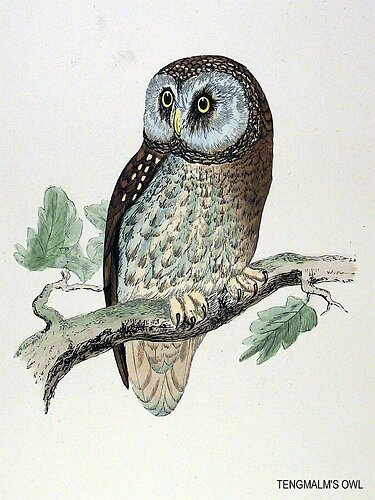TENGMALM'S OWL
TENGMALM'S NIGHT OWL.
Strix Tengmalmi, GMELIN. LATHAM. Strix funerea, LiNNAEus. Noctua Tengmalmi,
JENYNS.
Strix—Some species of Owl. Tengmalmi—Of Tengmalm.
This pretty little Owl received its specific name from
Gmelin, in compliment to the discoverer, Dr. Tengmalm, an able ornithologist
who lived near Stockholm, in Sweden.
It inhabits principally the northern parts of Europe—Russia,
Sweden, Livonia, and Norway, and has also been met with in Germany,
France, and transalpine Italy. It is said to be very abundant in North
America.
In Yorkshire one was killed at Hunmanby, in the East-Riding, by Admiral
Mitford's gamekeeper, about 1847. In 1836 a specimen, recently shot,
was purchased in a poulterer's shop in London; another was killed
the same year in Kent; one on the sea-coast near Marsden, in the county
of Durham, in October, 1848; and one near Morpeth, in Northumberland,
in 1812. In 1881, on the 3rd. of November, one at the Light House
at Cromer in Norfolk, of which Samuel Gurney Esq., has written me
word.
There has as yet been no discovery of the occurrence of this species
in Ireland. In Scotland, one was killed in May, 1847, at Spinning-dale,
in Sutherlandshire. In Orkney one was shot in Waas, in 1851, by Dr.
M. F. Heddle.
This bird is strictly nocturnal in its habits, and is so dazzled by
the light of the sun, if by any accident forced into it, that it may
easily be caught with the hand. It frequents wooded districts—the
thick and extensive pine forests of the north, and orchards, and other
lesser plantations. It may be easily tamed, even if taken in the adult
state, and exhibits many amusing positions. It erects the feathers
of the face at times to a considerable extent.
In flight this Owl is light and easy.
Its food consists of mice, small birds, moths, beetles and other insects.
It does not swallow its prey whole.
The note sounds like the syllables 'keu, keu, kook kook,' varied in
the breeding season into 'kuk, kuk,' repeated for several minutes
at a time, at intervals of a minute or two. It is one of the superstitions
of the Indians to whistle when they hear it, as sailors do in a calm
when wishing for a breeze. The silence of the bird in reply, to use
an Iricism, is considered an omen of death.
These Owls are said to breed in holes of trees, half way up them,
or in Church towers, and as being deficient in such an 'Exhibition
of Industry,' to make no manner of nest, or only to use a little grass
for the purpose.
The eggs are white, and from two in number, to four or five.
Male; length, from eight inches and a half to nine and a half; bill,
pale greyish yellow or bluish white, darker on the sides, hid at the
base by the feathers. Cere, sometimes dashed with black; iris, pale
yellow, the eyes are surrounded by a dark ring, forming a band, which
is broadest on the inner side. Head, reddish brown, spotted with small
yellowish white spots; the ruff yellowish or greyish white, mottled
or streaked with black over the eyes; crown, reddish brown; neck,
spotted behind as the head. Nape, as the head, the spots larger, forming
a sort of band; chin and throat, brown and greyish white. Breast,
yellowish or greyish white, indistinctly streaked with lighter brown
on the centre of each feather in the upper part, but only the tip
on the lower; back, reddish brown,but the spots larger than on the
head.
The wings expand to the width of one foot eleven inches; greater and
lesser wing coverts, reddish brown, partially spotted with white.
Primaries, reddish brown, barred on the outer webs with three or four
oval white spots, the third and fourth are the longest in the wing,
the latter the longer of the two; Meyer says the former. They reach
to within an inch of the end of the tail. Tertiaries the same, the
spots more square; greater and lesser under wing coverts, white, clouded
with brown. Tail, reddish brown, slightly rounded, and barred with
four or five series of narrow white spots; it extends about an inch
beyond the wings: it is greyish white beneath, the bars shewing through;
under tail coverts, white. Legs, short, and as the toes, yellow, feathered
with very soft greyish or whitish yellow hairy feathers, slightly
spotted with brown. Claws, slender, yellowish brown, and dusky at
the tips.
The female measures from nine inches and a half to eleven and a half;
the face, dull white, the black spot over the eye smaller and paler
than in the male. Breast, more spotted than in the male, and the brown
of the back darker.
Young; length, eight to nine inches; bill, yellowish grey; iris, yellow.
The bristly feathers of the face dusky black, with white bases; the
ruff brown, but indistinct, a little spotted with white around the
eyes. Breast, whitish, mingled with brown; back, reddish brown; primaries,
barred with four rows of small round spots. Tail, barred as the wings;
under tail coverts, dull white tipped with brown.
"The Owlets started from their dream."
The Lady of the Lake.
